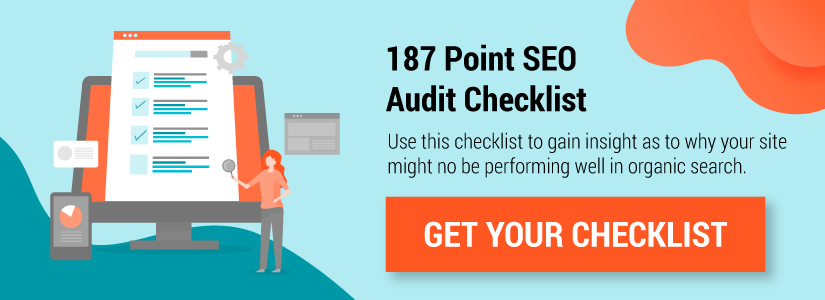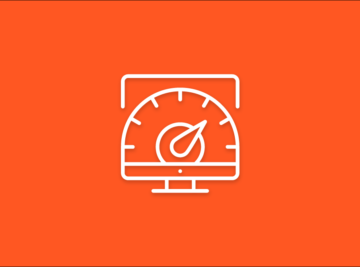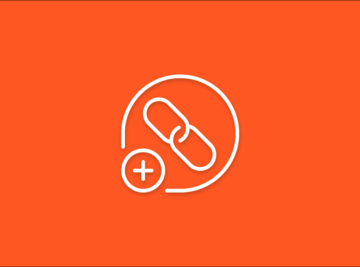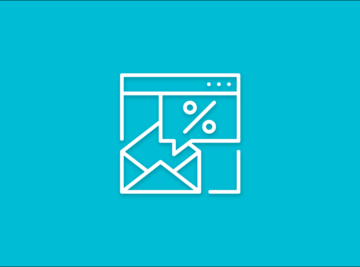If you’re reading this blog post you’re most likely trying to improve your rankings in organic search with the goal of getting more qualified traffic to your site. You’re in the right place!
By the end of this blog post, you will have an understanding of:
-
What on-page SEO is
-
Why it’s so important
-
The different on-page elements you should pay close attention to
We outline 12 on-page elements factors and how you can optimize each one.
What is on-page SEO?
On-page SEO is a form of search engine optimization that focuses on ranking factors found within your content itself). It refers to how well your on-page elements are optimized for search.
Is On-Page SEO The Only Thing Holding Back Your Website? Find Out With Our 187 Point Self-Audit Checklist!

Consider one of your most recently published pieces of content. Even if you create the most in-depth, thorough guide on a topic and fill it with compelling graphics and value that blows your competition out of the water, if you have poorly optimized on-page elements, your rankings will suffer.
Updating and testing different changes to these elements could help you improve your rankings from #30 to #1 for the keyword you are targeting—a massive ROI for very little actual work.
Why should I be concerned about it?
On-page SEO is something we focus on the most with our SEO clients, and for a simple reason: It’s important.
For example, with any SEO client, we always start off by auditing their most valuable pages title tags and meta descriptions. Why? Optimizing these can create some quick wins for any site because they are so powerful. This power is compounded each time you tackle and optimize a new on-page element.

In the image above, you can see what kind of impact simply optimizing title tags can have for a website. By aligning each page with a targeted keyword and optimizing your title tags and meta descriptions to include that keyword, you can quickly improve your rankings because you are making it easier for both Google and the searcher to understand what your content is about.
This is just one on-page SEO tactic you can use to rank higher in search. What are the other ones you may be asking; let’s discuss.
12 Ranking Factors of On-Page SEO
1. Title Tag
Your title tag is your first interaction with a searcher, so its importance cannot be overstated. Whenever I put myself in a searcher’s shoes, I always start with a search I think they’re going to do to try to find my content. If that returns a positive result, I’ll validate that idea with keyword research.
You want to include your targeted keyword in your title tag. The structure should look something like this:
Targeted Keyword w/ Additional Context | Your Website Name

Aim to have your title tags under 70 characters. This will ensure that your title doesn’t get truncated. Let’s just say my targeted keyword was “benefits of podcasting”, this might be an option for a title tag.
12 Benefits of Podcasting For Business | Pepperland Marketing
It’s within the character count and gives the searcher additional context while differentiating myself from other pages found on the search results page.
If it wasn’t within character count, it might look something like this:

2. Meta Description
Your meta description will follow a lot of the same guidance as your title tag. You want to make sure to include your targeted keyword and maybe a secondary keyword as long as it doesn’t sound forced. Your meta description should give the searcher a concise summary of what they can expect by clicking through to your site.
Generally, you want to keep your meta descriptions around 156 characters. Again, this is so it doesn’t get truncated. Consider the example above, if I’m targeting the keyword “benefits of podcasting” my meta description might look like this:

This meta description already starts to give the reader an insight as to the benefits businesses can have by starting a podcast. This meta description is specific, clear, and concise. It directly addresses the searchers questions and should get them to click through to our page.
If it wasn’t within character count, it might look something like this:

3. URL structure
Before publishing a new page or blog post, you want to make sure you have a clean URL. You want to make sure to include your targeted keyword within your URL so users can easily understand it.
Here’s a short checklist of things you’ll want to keep in mind when writing your URLs:
- The URL includes the targeted keyword
- The URL is not cumbersome or overly long
- The URL consists of lowercase letters
- The URL includes dashes between words
- The URL does not include underscores, spaces, or other characters
Adding this clarity also helps search engines understand the page more. The less friction search engines have when trying to understand the content on your page, the more reward you will get when it comes time to rank your content.
4. Header Tags & Content Organization
When Google crawls and indexes your page, it looks at the different headings you have to try to get some context as to what your article or page is all about. Header tags are a helpful way of guiding search engines to better understand your content.
Headers play an important role when it comes to structuring your content. An H1 traditionally is the title of your piece. Then as you address sub-topics or sub-ideas you would use the other header tags as a way of structuring the importance of the information.

In the picture above, I’ve outlined how you should think about each header. Keep in mind, this is just one combination of you can structure your content. Each topic you target will have its own winning structure and testing different variations is how you can climb the ranks.
Header tags can also present a good opportunity for incorporating secondary keywords into your page. You can also use clues from the SERP of your targeted keyword for clues on what to include. Let’s go back to our example search for “benefits of podcasting”. If you scroll all the way to the bottom of that search results page, you’ll see the following:

This related search box can give you clues as to what secondary searches users are doing when they are thinking about this topic. You may also see a “People also asked” box.

Again, this is a good clue as to the types of things users are looking for or asking when exploring this idea. You might want to address some of these questions in your content, or include them as a header.
5. Alt Text
Image alt text is another way you can guide search engines to best understand your content. Additionally, optimized alt text can help you see a rise in image searches too. You want to be as clear as possible when including image alt text. Describe exactly what the image represents even if it’s self-explanatory.

Consider the image above. The alt text reads “Podcasting Consumption Through App Pie Chart Breakdown”. I’m giving Google additional context as to what the image is displaying, this will help me rank for additional terms in image searches, positive accessibility considerations, and ability to add in secondary keywords.
If you can, you’ll also want to keep your image files as descriptive as possible. While alt text is the primary focus, it can’t hurt to have a clean and clear image file description.
Another reason to use clear, descriptive alt text? It is crucial for readers who are visually impaired or who use a screen reader. Clear alt text can therefore help your website become more accessible.
6. Descriptive Anchor Text
Anchor text is the hyperlinked text you use to send a user to an additional resource. It gives search engines clues about the information you’re linking to in your blog post, whether that be an internal link or external. Again, these are a great way of including secondary keywords or leading your users down a certain path.

When you add a link in your content to another one of your internal resources, make sure the text you’re linking carries the right context for the page you are linking to. The anchor text should be clearly aligned with its target. For example, you wouldn’t want to link to the phrase “on-page SEO” and send someone to your inbound marketing services page; it wouldn’t make any sense.
7. Internal Linking
Internal linking is the process of linking a piece of content to other pieces of content on your website. It creates multiple avenues for search engines and users to discover more of your content.

While you always want to include internal links within your content, you don’t want to overload the page. You shouldn’t be linking to a page just because the anchor text speaks directly to that page. You should include it if it adds additional context to the topics you’re discussing.
I would say you don’t want to include more than 10 internal links within an average blog post. Adding too many internal links can seem spammy and could turn-off your user.
8. External Linking
External linking refers to the process of linking to an external resource—one not hosted on your site. It is a powerful tool, but you also want to use it sparingly.
When linking to an external source, you’ll want to make sure that link opens in a new tab. This ensures your user always has a path back to your website because they never actually left.
Linking to external websites allows you to bring in other expert opinions and ideas that help to enhance your content. I’d recommend putting no more than 3 external links in your content. When adding in these links, make sure you aren’t linking to any competing sites that are already ranking on the SERP of your targeted term.
9. Backlinks
Backlinks have always been a hot-topic for the SEO world. Backlinks are arguably the most influential part of SEO. Technically, they aren’t really a part of on-page SEO, but they play such a big role in ranking that I couldn’t leave them out.
Backlinks are an indication that your content is influential and authoritative enough that people are using it as a reference for their own work. The more backlinks your individual pages and domain as a whole get, the more influential your content is seen to be. Think of it like a cheat sheet that Google uses to understand whether or not it should trust you enough to rank you for a query.
Just to be clear, buying links is bad. The best way to acquire backlinks is to write great, compelling content. Link building campaigns and email outreach can be an effective way of building up your backlink profile.
10. Meaningful Content
While all of these on-page elements matter, the most important piece is writing content that actually helps the searcher accomplish a goal or find an answer to their problems. You should first write your content in a compelling and helpful way and then go back and edit for SEO.
As you get more comfortable with this process, you’ll be able to do both simultaneously. You’ll be able to write compelling content while optimizing for the top spot in search results.
11. E-A-T
The acronym E-A-T stands for expertise, authority, and trustworthiness, three factors that Google takes into account when it is deciding where to rank content. You can display each element of this acronym in how you write your content.
For example, if you want to show expertise within your content, you might conduct your own research and incorporate that data into your blog post. Or, you might include a quote from an expert..
Authority can be tied to how often this work is cited in other works. (This goes back to the idea of acquiring backlinks.)
Trustworthiness takes into account your site as a whole. Can people reach out to you? Is your domain secure? Do you have a privacy policy?
Building up a positive E-A-T reputation can take some time, but consistency and persistence will serve you well.
12. Speed
The speed of your website also plays a big role in your ranking abilities. Why would Google rank your content higher if someone else’s is just as good as yours, but loads faster? People are looking for the answer to their problems as fast as they can because they have an immediate need.
There are many, many potential pathways for improving the speed of your website. Some options that can have a quick impact include things like compressing CSS, optimizing HTML, deferring unused JavaScripts and optimizing images are all things you should take into consideration when optimizing for speed.
Not sure where you stand? Use our free self-audit.
Our team of analysts can give you a full, holistic view of what is holding your website back from ranking higher and getting more traffic. We can give you a full plan of what you should be tackling first in order to get quick traffic and SEO wins.
We blend the use of the industry’s top tools with our consultants’ trained eyes to uncover a comprehensive list of your website’s issues—both large and small. We then prepare a detailed document that outlines each issue, why it matters, and how you should fix it.








